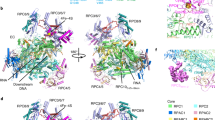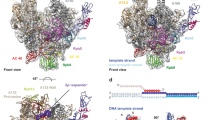Abstract
The catalytic center of yeast RNA polymerase II and III contains an acidic loop borne by their second largest subunit (Rpb2-832GYNQED837, Rpc128-764GYDIED769) and highly conserved in all cellular and viral DNA-dependent RNA polymerases. A site-directed mutagenesis of this dicarboxylic motif reveals its strictly essential character in RNA polymerase III, with a slightly less stringent pattern in RNA polymerase II, where rpb2-E836Q and other substitutions completely prevent growth, whereas rpb2-E836A combines a dominant growth defect with severe lethal sectoring. A mild but systematic increase in RNA polymerase occupancy and a strict dependency on the transcript cleavage factor TFIIS (Dst1) also suggest a slower rate of translocation or higher probability of transcriptional stalling in this mutation. A conserved nucleotide triphosphate funnel domain binds the Rpb2-832GYNQED837 loop by an Rpb2-R1020/Rpb2-D837 salt-bridge. Molecular dynamic simulations reveal a second bridge (Rpb1-K752/Rpb2-E836), which may account for the critical role of the invariant Rpb2-E836. Rpb2-E836 and the funnel domain are not found among the RNA-dependent eukaryotic RNA polymerases and may thus represent a specific adaptation to double-stranded DNA templates.




Similar content being viewed by others
References
Albert B, Leger-Silvestre I, Normand C, Ostermaier MK, Perez-Fernandez J, Panov KI, Zomerdijk JC, Schultz P, Gadal O (2011) RNA polymerase I-specific subunits promote polymerase clustering to enhance the rRNA gene transcription cycle. J Cell Biol 192:277–293
Alic N, Ayoub N, Landrieux E, Favry E, Baudouin-Cornu P, Riva M, Carles C (2007) Selectivity and proofreading both contribute significantly to the fidelity of RNA polymerase III transcription. Proc Natl Acad Sci U S A 104:10400–10405
Archambault J, Lacroute F, Ruet A, Friesen JD (1992) Genetic interaction between transcription elongation factor TFIIS and RNA polymerase II. Mol Cell Biol 12:4142–4152
Cramer P, Armache KJ, Baumli S, Benkert S, Brueckner F, Buchen C, Damsma GE, Dengl S, Geiger SR, Jasiak AJ, Jawhari A, Jennebach S, Kamenski T, Kettenberger H, Kuhn CD, Lehmann E, Leike K, Sydow JF, Vannini A (2008) Structure of eukaryotic RNA polymerases. Annu Rev Biophys 37:337–352
Dieci G, Sentenac A (1996) Facilitated recycling pathway for RNA polymerase III. Cell 84:245–252
Dieci G, Hermann-Le Denmat S, Lukhtanov E, Thuriaux P, Werner M, Sentenac A (1995) A universally conserved region of the largest subunit participates in the active site of RNA polymerase III. EMBO J 14:3766–3776
Ghavi-Helm Y, Michaut M, Acker J, Aude JC, Thuriaux P, Werner M, Soutourina J (2008) Genome-wide location analysis reveals a role of TFIIS in RNA polymerase III transcription. Genes Dev 22:1934–1947
Guarino LA, Xu B, Jin J, Dong W (1998) A virus-encoded RNA polymerase purified from baculovirus-infected cells. J Virol 72:7985–7991
Indest KJ, Jung CM, Chen HP, Hancock D, Florizone C, Eltis LD, Crocker FH (2010) Functional characterization of pGKT2, a 182-kilobase plasmid containing the xplAB genes, which are involved in the degradation of hexahydro-1, 3, 5-trinitro-1, 3, 5-triazine by Gordonia sp. strain KTR9. Appl Environ Microbiol 76:6329–6337
Iyer LM, Koonin EV, Aravind L (2003) Evolutionary connection between the catalytic subunits of DNA-dependent RNA polymerases and eukaryotic RNA-dependent RNA polymerases and the origin of RNA polymerases. BMC Struct Biol 3:1
Iyer LM, Balaji S, Koonin EV, Aravind L (2006) Evolutionary genomics of nucleo-cytoplasmic large DNA viruses. Virus Res 117:156–184
Izban MG, Luse DS (1993) The increment of SII-facilitated transcript cleavage varies dramatically between elongation competent and incompetent RNA polymerase II ternary complexes. J Biol Chem 268:12874–12885
Kettenberger H, Armache KJ, Cramer P (2004) Complete RNA polymerase II elongation complex structure and its interactions with NTP and TFIIS. Mol Cell 16:955–965
Lane WJ, Darst SA (2010) Molecular evolution of multisubunit RNA polymerases: structural analysis. J Mol Biol 395:686–704
Langelier MF, Baali D, Trinh V, Greenblatt J, Archambault J, Coulombe B (2005) The highly conserved glutamic acid 791 of Rpb2 is involved in the binding of NTP and Mg(B) in the active center of human RNA polymerase II. Nucleic Acids Res 33:2629–2639
Malagon F, Kireeva ML, Shafer BK, Lubkowska L, Kashlev M, Strathern JN (2006) Mutations in the Saccharomyces cerevisiae RPB1 gene conferring hypersensitivity to 6-azauracil. Genetics 172:2201–2209
Nudler E (2009) RNA polymerase active center: the molecular engine of transcription. Annu Rev Biochem 78:335–361
Reines D, Chamberlin MJ, Kane CM (1989) Transcription elongation factor SII (TFIIS) enables RNA polymerase II to elongate through a block to transcription in a human gene in vitro. J Biol Chem 264:10799–10809
Rozenfeld S, Thuriaux P (2001) A genetic look at the active site of RNA polymerase III. EMBO Rep 2:598–603
Ruprich-Robert G, Thuriaux P (2010) Non-canonical DNA transcription enzymes and the conservation of two-barrel RNA polymerases. Nucleic Acids Res 38:4559–4569
Salgado PS, Koivunen MR, Makeyev EV, Bamford DH, Stuart DI, Grimes JM (2006) The structure of an RNAi polymerase links RNA silencing and transcription. PLoS Biol 4:e434
Shpakovski GV, Acker J, Wintzerith M, Lacroix JF, Thuriaux P, Vigneron M (1995) Four subunits shared by the three classes of RNA polymerases are functionally interchangeable between Homo sapiens and Saccharomyces cerevisiae. Mol Cell Biol 15:4702–4710
Sigurdsson S, Dirac-Svejstrup AB, Svejstrup JQ (2010) Evidence that transcript cleavage is essential for RNA polymerase II transcription and cell viability. Mol Cell 38:202–210
Steitz TA (1998) DNA polymerases: structural diversity and common mechanisms. J Biol Chem 274:17395–17398
Svejstrup JQ (2010) The interface between transcription and mechanisms maintaining genome integrity. Trends Biochem Sci 35:333–338
Thomas JA, Rolando MR, Carroll CA, Shen PS, Belnap DM, Weintraub ST, Serwer P, Hardies SC (2008) Characterization of Pseudomonas chlororaphis myovirus 201varphi2–1 via genomic sequencing, mass spectrometry, and electron microscopy. Virology 376:330–338
Treich I, Carles C, Sentenac A, Riva M (1992) Determination of lysine residues affinity labeled in the active site of yeast RNA polymerase II(B) by mutagenesis. Nucleic Acids Res 20:4721–4725
Van Mullem V, Wery M, De Bolle X, Vandenhaute J (2003) Construction of a set of Saccharomyces cerevisiae vectors designed for recombinational cloning. Yeast 20:739–746
Vassylyev DG, Vassylyeva MN, Zhang J, Palangat M, Artsimovitch I, Landick R (2007) Structural basis for substrate loading in bacterial RNA polymerase. Nature 448:163–168
Wang Y, Jehle JA (2009) Nudiviruses and other large, double-stranded circular DNA viruses of invertebrates: new insights on an old topic. J Invertebr Pathol 101:187–193
Wang D, Bushnell DA, Westover KD, Kaplan CD, Kornberg RD (2006) Structural basis of transcription: role of the trigger loop in substrate specificity and catalysis. Cell 127:941–954
Werner F, Grohmann D (2010) Evolution of multisubunit RNA polymerases in the three domains of life. Nat Rev Microbiol 9:85–98
Werner F, Weinzierl RO (2002) A recombinant RNA polymerase II-like enzyme capable of promoter-specific transcription. Mol Cell 10:635–646
Werner M, Thuriaux P, Soutourina J (2009) Structure-function analysis of RNA polymerases I and III. Curr Opin Struct Biol 19:740–745
Wery M, Shematorova E, Van Driessche B, Vandenhaute J, Thuriaux P, Van Mullem V (2004) Members of the SAGA and mediator complexes are partners of the transcription elongation factor TFIIS. EMBO J 23:4232–4242
Westover KD, Bushnell DA, Kornberg RD (2004) Structural basis of transcription: nucleotide selection by rotation in the RNA polymerase II active center. Cell 119:481–489
Acknowledgments
We thank Maria-Pilar Gomez for her help in the Rpb2 mutagenesis and Sylvie Mariotte, Marta Kwapisz, Marina Pinskaya, Elena Shematorova, Julie Soutourina and Michel Werner for useful discussions. This work was supported by the French Agence Nationale de la Recherche (BLAN08-3-309259) and by a fellowship from the Association pour la Recherche sur le Cancer to D.D.
Author information
Authors and Affiliations
Corresponding author
Additional information
Communicated by K. Breunig.
Electronic supplementary material
Below is the link to the electronic supplementary material.
Rights and permissions
About this article
Cite this article
Ruprich-Robert, G., Wery, M., Després, D. et al. Crucial role of a dicarboxylic motif in the catalytic center of yeast RNA polymerases. Curr Genet 57, 327–334 (2011). https://doi.org/10.1007/s00294-011-0350-6
Received:
Revised:
Accepted:
Published:
Issue Date:
DOI: https://doi.org/10.1007/s00294-011-0350-6




